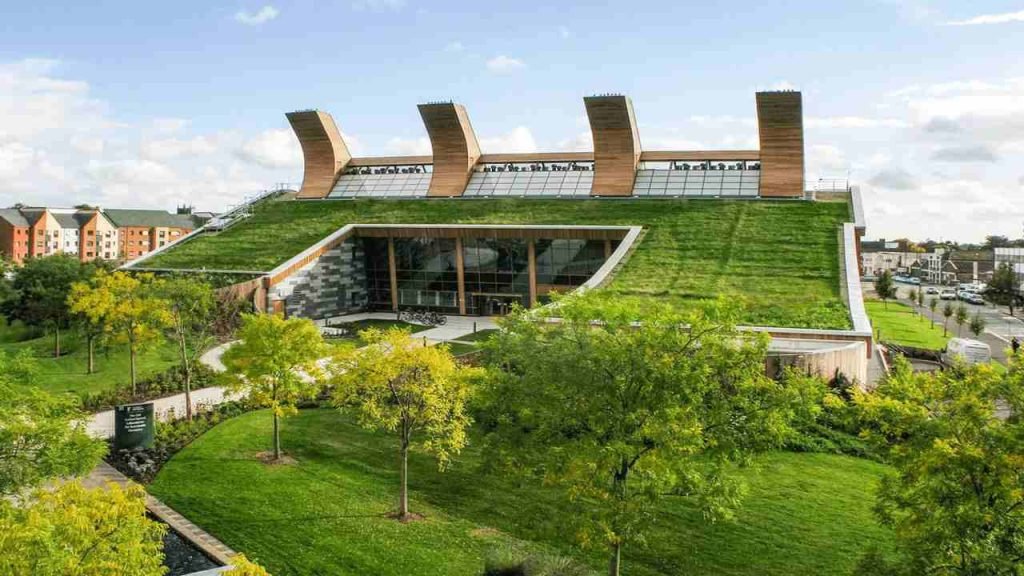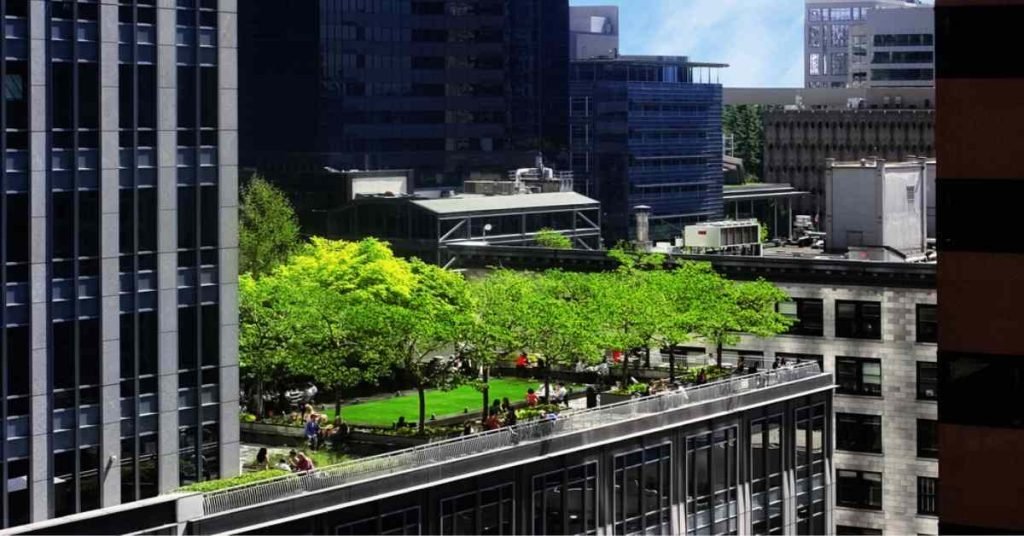Green roofs are fantastic for the environment! They help lower urban temperatures by providing natural insulation and reduce energy consumption. Plus, they manage stormwater effectively, which helps prevent flooding and reduces runoff pollution. Green roofs also improve air quality by absorbing pollutants and provide valuable habitats for birds and insects. If you’re considering installing one, EThandyman Services can help with the process. They’re great at handling kitchen remodels and other home improvements, so you can trust them to add a green roof to your space efficiently and professionally.
What is a Green Roof?
A green roof is a rooftop covered with vegetation and soil, designed to provide environmental benefits like reducing heat absorption and managing stormwater. It includes layers for drainage, waterproofing, and growing medium, supporting various plant types. Green roofs enhance energy efficiency, improve air quality, and provide wildlife habitat. For a successful installation, consider professional assistance from Roofing Services, which can ensure proper setup and long-term maintenance, optimizing the green roof’s performance and benefits.
First off, let’s clarify what we mean by a green roof. Simply put, a green roof is a roof that is partially or completely covered with vegetation. It typically includes layers of soil or growing medium, plants, and a waterproof membrane. These roofs can vary in complexity from simple, shallow systems with hardy plants to more elaborate setups with deeper soil and a wider variety of plants, including trees and shrubs.
1. Urban Heat Island Mitigation

One of the most noticeable benefits of green roofs is their ability to combat the urban heat island effect. Urban areas tend to be warmer than their rural surroundings due to the concentration of buildings, roads, and other heat-absorbing surfaces. This effect can lead to higher energy consumption as buildings need more cooling, and it can exacerbate air pollution.
Green roofs help mitigate this effect by providing a layer of vegetation that absorbs and reflects sunlight, reducing the heat absorbed by the building. The plants also cool the air through a process called evapotranspiration, where they release water vapor. As a result, green roofs can lower the temperature of the surrounding area and reduce the need for air conditioning in the building, leading to energy savings and a decrease in greenhouse gas emissions.
2. Stormwater Management
Green roofs play a crucial role in managing stormwater. Traditional roofs and pavements can lead to increased runoff during rainstorms, which can overwhelm drainage systems and cause flooding. This runoff can also carry pollutants into waterways, affecting water quality.
Green roofs help address this issue by capturing and retaining rainwater. The soil and vegetation absorb some of the water, and the rest evaporates. This reduces the volume of runoff and decreases the risk of flooding. Additionally, the plants and soil can filter out pollutants, improving the quality of the water that eventually does make it to the drainage system.
3. Improved Air Quality
Improved air quality is a key benefit of green roofs, as they absorb pollutants and release oxygen, enhancing urban environments. The roof replacement process typically involves several steps: assessing the existing roof condition, removing old materials, repairing any underlying damage, installing new roofing materials, and ensuring proper insulation and ventilation. Finally, a thorough inspection is conducted to confirm the installation meets all standards and specifications. Professional Roofing Services can guide you through each step for a successful replacement.
Green roofs contribute to better air quality in several ways. Plants on green roofs absorb pollutants such as carbon dioxide (CO2) and nitrogen oxides (NOx) from the air. They also trap particulate matter, like dust and soot, which can help reduce smog and improve overall air quality.
Furthermore, the cooling effect of green roofs can help lower the formation of ground-level ozone, a harmful pollutant that contributes to smog. By reducing the temperature and trapping pollutants, green roofs play a role in creating healthier, cleaner air in urban environments.
4. Energy Efficiency
Green roofs can significantly enhance the energy efficiency of buildings. The layer of vegetation provides insulation, helping to keep buildings warmer in the winter and cooler in the summer. This insulation reduces the demand for heating and cooling, leading to lower energy consumption and cost savings.
In the winter, the green roof acts as an extra layer of insulation, minimizing heat loss. In the summer, it helps to keep the building cooler by preventing excessive heat from entering. This dual benefit can lead to substantial energy savings and a reduction in the building’s carbon footprint.
5. Biodiversity and Habitat Creation
Green roofs offer valuable habitat space for wildlife in urban areas where natural habitats are often scarce. They can support a variety of plants, insects, birds, and even small mammals. This biodiversity can enhance the ecological value of urban spaces and provide important green corridors for wildlife.
Different types of green roofs can support different kinds of species. For example, extensive green roofs with hardy plants can provide habitat for pollinators like bees and butterflies, while more intensive green roofs with deeper soil can support a wider range of plants and animals. This biodiversity contributes to a healthier and more balanced urban ecosystem.
6. Aesthetic and Recreational Benefits
Beyond their environmental benefits, green roofs also offer aesthetic and recreational advantages. They can transform a plain, utilitarian roof into a lush, green space that adds visual appeal to a building. This can enhance the overall look of a neighborhood and improve the quality of life for residents.
Green roofs can also be used as recreational spaces. Rooftop gardens, patios, and even small parks can be created on green roofs, providing urban dwellers with much-needed green space and opportunities for relaxation and socializing. These spaces can be particularly valuable in densely populated urban areas where access to parks and nature is limited.
7. Extended Roof Lifespan

The additional layer of vegetation on a green roof can protect the underlying roofing materials from the elements. Green roofs shield the roof membrane from UV radiation, temperature fluctuations, and physical damage. This protection can extend the lifespan of the roof, reducing the need for frequent repairs or replacements.
By minimizing wear and tear on the roofing materials, green roofs can offer long-term cost savings and contribute to the sustainability of the building. This durability also means that green roofs can be a more economical choice over time compared to traditional roofing systems.
8. Economic and Community Benefits
Investing in green roofs can offer economic benefits beyond energy savings and reduced maintenance costs. Green roofs can increase property values and make buildings more attractive to tenants and buyers. They can also contribute to the overall attractiveness of a neighborhood, potentially boosting local businesses and fostering community pride.
Moreover, green roofs can create job opportunities in areas such as installation, maintenance, and plant care. This can have positive economic impacts at the local level and support green job growth.
Implementing Green Roofs with EThandyman Services
Implementing green roofs with EThandyman Services ensures expert installation and long-term performance. Their team handles everything from selecting the right system to managing installation and maintenance. To ensure quality in carpentry projects, focus on using high-grade materials, precise measurements, and skilled craftsmanship. EThandyman Services emphasizes attention to detail and thorough inspections, which guarantee that each project meets high standards and provides lasting value. Their expertise ensures both your green roof and carpentry projects are completed with excellence.
If you’re interested in adding a green roof to your property, it’s important to work with professionals who can ensure the installation is done right. EThandyman Services, known for their expertise in kitchen remodeling and various home improvement projects, also has experience with green roof installations. They can guide you through the process, from selecting the right system for your needs to ensuring proper installation and maintenance.
By choosing a reliable service like EThandyman Services, you can ensure that your green roof not only enhances the environmental performance of your building but also adds value and aesthetic appeal. Their expertise in handling complex projects ensures that your green roof will be installed efficiently and with attention to detail, making it a worthwhile investment for both you and the environment.
FAQs
What are the environmental benefits of green building?
Green building practices reduce environmental impact by enhancing energy efficiency, minimizing waste, and conserving natural resources. They improve indoor air quality and promote healthier living spaces through the use of sustainable materials and efficient systems. Additionally, green buildings often lower operational costs and contribute to the overall well-being of the community by supporting environmental sustainability.
What are some advantages and disadvantages of green roofs?
**Advantages of green roofs** include improved energy efficiency, reduced urban heat island effect, and enhanced stormwater management. **Disadvantages** can be the high initial installation cost, potential structural load requirements, and ongoing maintenance needs. Despite these challenges, the long-term environmental and economic benefits often outweigh the drawbacks.
How much CO2 does a green roof absorb?
A green roof can absorb between 1 to 3 kilograms of CO2 per square meter per year, depending on factors such as plant type, roof size, and climate. This absorption helps mitigate the impact of urban CO2 emissions and improves overall air quality. While not a replacement for larger-scale carbon reduction strategies, green roofs contribute positively to lowering urban carbon footprints.
What are the aesthetic benefits of a green roof?
Green roofs offer significant aesthetic benefits by transforming bland rooftops into vibrant, lush spaces that enhance the visual appeal of buildings. They provide a natural, calming contrast to urban environments and can create visually striking green oases that improve neighborhood attractiveness. Additionally, green roofs can be designed to include gardens, walkways, and recreational areas, further enhancing their aesthetic and functional value.
What are the environmental impacts of green roofs?
Green roofs help reduce urban heat islands, manage stormwater by absorbing and filtering runoff, and improve air quality through pollutant absorption and cooling effects. They also support biodiversity by providing habitat for wildlife and can extend the lifespan of roofing materials. However, they require careful design and maintenance to ensure they deliver these benefits effectively and sustainably.
Conclusion
Green roofs offer a multitude of environmental benefits that make them a valuable addition to urban spaces. From mitigating the urban heat island effect and managing stormwater to improving air quality and supporting biodiversity, green roofs contribute to a more sustainable and livable environment. They also provide aesthetic and recreational benefits, extend the lifespan of roofing materials, and offer economic advantages.
If you’re considering a green roof for your building, partnering with experienced professionals like EThandyman Services can help you achieve the best results. Their expertise ensures that your green roof will be a successful and beneficial addition to your property, enhancing both its environmental performance and overall value.






Recent Comments